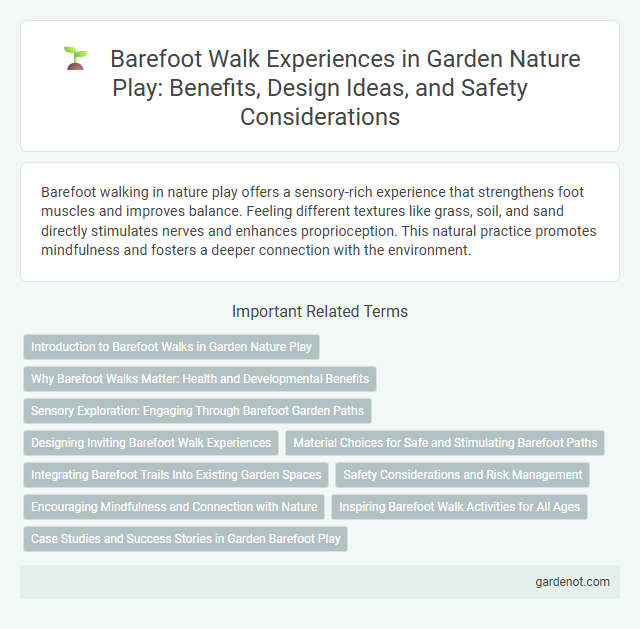Barefoot walking in nature play offers a sensory-rich experience that strengthens foot muscles and improves balance. Feeling different textures like grass, soil, and sand directly stimulates nerves and enhances proprioception. This natural practice promotes mindfulness and fosters a deeper connection with the environment.
Introduction to Barefoot Walks in Garden Nature Play
Barefoot walks in garden nature play enhance sensory exploration and physical development by engaging the feet directly with natural elements like soil, grass, and wood. This practice stimulates proprioception and balance while fostering a deeper connection to the outdoor environment. Incorporating barefoot walks supports holistic learning by combining tactile input with imaginative play.
Why Barefoot Walks Matter: Health and Developmental Benefits
Walking barefoot on natural surfaces strengthens foot muscles, improves balance, and enhances sensory development in children and adults. Exposure to varied textures like grass, soil, and sand stimulates tactile receptors, promoting neural pathways crucial for motor skills and cognitive growth. Regular barefoot walks reduce stress, improve circulation, and contribute to overall mental well-being by connecting individuals to the natural environment.
Sensory Exploration: Engaging Through Barefoot Garden Paths
Barefoot walks on garden paths enhance sensory exploration by stimulating nerve endings and increasing tactile awareness. Walking barefoot on natural surfaces like grass, soil, and wood activates proprioception, improving balance and body coordination. This immersive experience fosters deeper connections to nature, promoting mindfulness and emotional well-being.
Designing Inviting Barefoot Walk Experiences
Designing inviting barefoot walk experiences involves crafting diverse natural textures such as smooth pebbles, soft moss, warm sand, and cool water to stimulate sensory engagement and promote mindfulness. Incorporating varied terrain gradients and natural elements encourages exploration while enhancing balance and foot strength. Thoughtful placement of resting spots and educational signage enriches interaction, making barefoot walks immersive and restorative nature play activities.
Material Choices for Safe and Stimulating Barefoot Paths
Selecting natural materials such as smooth river stones, soft moss, and untreated wood chips creates a safe and sensory-rich barefoot walk, promoting tactile exploration and foot muscle development. Avoiding sharp or abrasive substances ensures comfort and reduces injury risks, while varied textures encourage balance and proprioception in children. Incorporating locally sourced, non-toxic materials supports environmental sustainability and enhances the overall sensory experience of nature play barefoot paths.
Integrating Barefoot Trails Into Existing Garden Spaces
Integrating barefoot trails into existing garden spaces enhances sensory connection by utilizing natural textures like soil, grass, and smooth stones to stimulate foot reflexology. Designing paths that weave around native plants and shaded areas promotes mindfulness and encourages children to engage deeply with their environment. Incorporating varied terrain and organic materials supports balance, coordination, and a holistic nature play experience within familiar garden settings.
Safety Considerations and Risk Management
Barefoot walks in nature encourage sensory engagement but require careful safety considerations such as inspecting paths for sharp objects, uneven terrain, or potential allergens to prevent injuries. Risk management strategies include educating participants about safe walking techniques, monitoring weather conditions to avoid hazardous surfaces, and having first aid resources readily available. Ensuring a balanced approach between exploration and caution minimizes risks while maximizing the therapeutic benefits of barefoot nature play.
Encouraging Mindfulness and Connection with Nature
Barefoot walks enhance sensory engagement by allowing direct contact with natural elements like soil, grass, and leaves, fostering a deeper connection with the environment. This practice promotes mindfulness as individuals become more aware of textures, temperatures, and subtle sounds, grounding their attention in the present moment. Engaging the feet in nature's varied terrains supports holistic wellness and encourages mental clarity through immersive, tactile experiences.
Inspiring Barefoot Walk Activities for All Ages
Barefoot walk activities engage all ages in sensory exploration and natural grounding, enhancing balance and mindfulness. Paths featuring varied textures like grass, sand, and smooth stones stimulate tactile awareness and foot strength while promoting connection to nature. Incorporating barefoot hikes, mud play, and leaf-treading encourages physical development and emotional well-being through immersive, outdoor experiences.
Case Studies and Success Stories in Garden Barefoot Play
Case studies in garden barefoot play demonstrate significant benefits in sensory development and physical health among children. Success stories reveal increased environmental awareness and enhanced motor skills through regular barefoot walking on natural surfaces like grass, soil, and pebbles. These documented outcomes highlight the importance of integrating barefoot paths into garden play spaces for holistic childhood growth.
Barefoot walk Infographic

 gardenot.com
gardenot.com